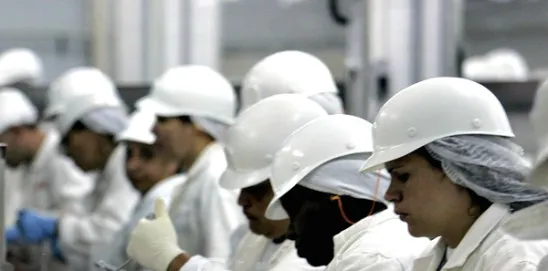On April 26, 2020, the Centers for Disease Control and Prevention (CDC) and the Occupational Safety and Health Administration (OSHA) issued guidance on COVID-19 for “Meat and Poultry Processing Workers and Employers” that is intended to supplement general guidance previously provided by OSHA and the CDC. The guidance was issued following news accounts of COVID-19 at multiple meat and poultry facilities as well as a lawsuit seeking to close a pork processing facility in Missouri.
The Guidance
The guidance explains that while workers involved in meat and poultry processing are not exposed to COVID-19 through the meat products they handle, the CDC and OSHA have identified several factors in meat and poultry processing facilities that may contribute to the risk of COVID-19 exposure. These factors include working closely together on processing lines for prolonged periods, contact with commonly used tools, and use of shared spaces such as locker rooms and break rooms. The guidance also notes that workers at these facilities may carpool or share transportation, and that there may be “[f]requent contact with fellow workers in community settings in areas where there is ongoing community transmission.”
The guidance contains an extensive list of recommendations to reduce employee risk of exposure to COVID-19. Some of these recommendations are familiar—encouraging ill workers to stay home and frequently cleaning and disinfecting common areas. Others are unique or may have a significant impact on meat and poultry employers. The guidance recommends that employers create a COVID-19 assessment and control plan that includes the following steps:
-
Identify a “qualified workplace coordinator” who is responsible for conducting the assessment and developing the control plan.
-
Implement engineering controls, such as:
-
“Modify the alignment of workstations, including along processing lines, if feasible, so that workers are at least six feet apart in all directions (e.g., side-to-side and when facing one another), when possible.”
-
“Use physical barriers, such as strip curtains, plexiglass or similar materials, or other impermeable dividers or partitions, to separate meat and poultry processing workers from each other, if feasible.”
-
“[E]nsure adequate ventilation in work areas to help minimize workers’ potential exposures.”
-
“Remove or rearrange chairs and tables, or add partitions to tables, in break rooms and other areas workers may frequent to increase worker separation.”
-
-
Implement administrative controls, such as:
-
“[W]ear[] face coverings as a protective measure in addition to social distancing (i.e., staying at least 6 feet away from others).” According to the CDC, “employers should provide readily available clean cloth face coverings (or disposable facemask options) for workers to use when the coverings become wet, soiled, or otherwise visibly contaminated.”
-
Consider grouping workers together. According to the guidance, “[t]his can increase the effectiveness of altering the plant’s normal shift schedules by making sure that groups of workers are always assigned to the same shifts with the same coworkers.”
-
Promote social distancing (e.g., designate monitors to facilitate distancing on the floor lines, stagger break times or provide temporary break areas and restrooms to avoid groups during breaks, and encourage workers to avoid carpooling, if possible).
-
Modify processing or production lines, and stagger workers across shifts to help maintain capacity while measures to minimize exposure to COVID-19 are in place.
-
Review and modify leave and incentive policies to ensure that ill workers are not in the workplace and incentive programs do not penalize workers for taking sick leave if they have COVID-19.
-
-
Screen and monitor workers for COVID-19 symptoms as an optional strategy. Options to screen workers for COVID-19 symptoms include:
-
“Screen prior to entry into the facility.
-
Provide verbal screening in appropriate language(s) to determine whether workers have had a fever, felt feverish, or had chills, coughing, or difficulty breathing in the past 24 hours.
-
Check temperatures of workers at the start of each shift to identify anyone with a fever of 100.4℉ or greater (or reported feelings of feverishness).”
-
Is the Guidance Enforceable?
The key question posed by employers in the meat and poultry processing industries is: Must we follow this guidance and what if we cannot implement all of it? OSHA may (and frequently does) use guidance to support alleged violations of Section 5(a)(1) of the Occupational Safety and Health Act, also known as the general duty clause. Under Arcadian Corp., 20 BNA OSHC 2001 (No. 93-0628, 2004), to prove a violation of Section 5(a)(1) for COVID-19, OSHA is required to show: 1) a COVID-19 hazard that could cause serious physical harm or death existed in the workplace; 2) the COVID-19 hazard was “recognized” by the employer or its industry; and 3) feasible means to abate the COVID-19 hazard existed and were not effectively implemented.
OSHA frequently relies on its own guidance or guidance from other agencies to show that a hazard is “recognized” in an industry or to prove that abatement measures are feasible. In the case of COVID-19, this evidence may not be persuasive given that OSHA and the CDC likely did not engage in factfinding to determine how effective the measures would be at preventing COVID-19 or whether meat or poultry processors could implement them. The guidance is replete language about taking “feasible” steps and measures employers “should” take, which means that CDC and OSHA may have anticipated that not all of the recommended steps could be implemented.
Meat and poultry processors analyzing the guidance may want to consider whether particular steps are feasible to implement given the realities of their worksites and whether the steps will materially reduce the risk. To prove a violation of Section 5(a)(1), OSHA must show that the abatement methods undertaken by the employer to address the hazard were inadequate.
With COVID-19, the stakes are higher than a potential violation of OSHA’s general duty clause. On April 26, 2020, a federal judge issued [an order] directing Smithfield Foods, Inc. to “follow all OSHA requirements and all guidance from CDC and other public authorities” at its facility in Milan, Missouri. The order was issued in response to a lawsuit filed against Smithfield on April 23, 2020, alleging that the company failed to adequately protect workers at the plant. The company reportedly has at least eight employees who have stayed home after exhibiting COVID-19 symptoms. OSHA has also initiated an investigation at the Milan facility that remains open and active.
This appears to be the first time that employees have sought the assistance of the courts to force their employers to abide by federal guidelines to protect workers from COVID-19. And the judge’s order is somewhat troubling because it enforces federal guidelines—not regulations or standards—that were prepared without notice-and-comment rulemaking or any input from stakeholders or the public.
Key Takeaways for Meat, Poultry, and Other Industries
Protection for Temperature Screeners
The guidance marks the first time OSHA has provided information on steps employers should take to protect employees tasked with taking the temperatures of other employees. The guidance states these employees should receive training and suggests that social distancing between screeners and workers being screened could be maintained by using “physical barriers or dividers or rope and stanchion systems.” More importantly, OSHA and the CDC address personal protective equipment (PPE) by stating:
-
“If screeners need to be within six feet of workers, provide them with the appropriate PPE based on the repeated close contact the screeners have with other workers.”
-
“Such PPE may include gloves, a gown, a face shield, and, at a minimum, a face mask.”
-
“N95 filtering facepiece respirators (or more protective) may be appropriate for workers performing screening duties and necessary for workers managing a sick employee in the work environment…if that employee has signs or symptoms of COVID-19.”
-
This suggests that N95s—which are scarce—may not be necessary under the systems many employers have implemented (such as where employees are trained and told not to come to work if they are experiencing symptoms). Once employees arrive at the worksite, they are screened using CDC questions about whether they have symptoms. Assuming they do not, employee temperatures are taken. The guidance suggests that under these circumstances, N95s may not be necessary for the employee-screeners taking temperatures of workers who have affirmatively stated they do not have symptoms. However, the guidance is not crystal clear on this point.
Cloth Face Coverings
OSHA also confirms for the first time in writing that “cloth face coverings are not PPE.” This is because “[c]loth face coverings are intended to protect other people—not the wearer.” This may have enforcement implications. Specifically, 29 C.F.R. 1910.132 of OSHA’s PPE standard requires employers to provide training on PPE and to pay for all PPE. To the extent OSHA concludes that training and payment are necessary to address COVID-19, the agency may be required to issue a general duty clause violation, which presents a more challenging evidentiary scheme.





 />i
/>i

